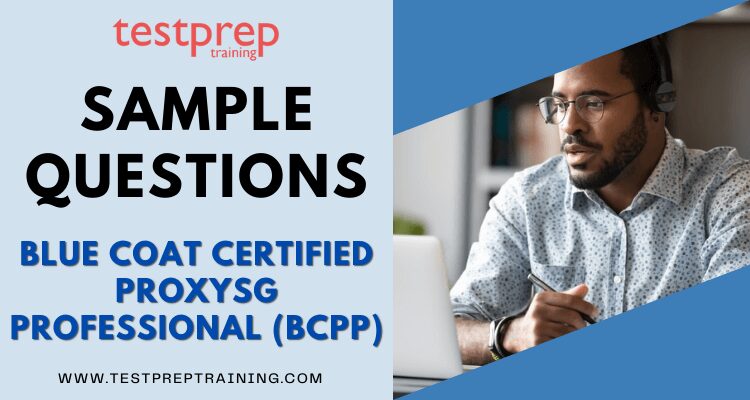Blue Coat (BCCPP): Certified ProxySG Professional Sample Questions

Question 1 – Which of the following type of SGOS software workers could be invoked for performing the pipelining of HTTP requests?
- A. Client worker.
- B. Server worker.
- C. Retrieval worker.
- D. SGOS software workers do not perform pipelining of HTTP requests.
Answer : B
Question 2 – In ProxyAV anti-virus scanners are ____
- A. multiple parallel threads sharing the same code and the same address space
- B. multiple parallel processes not sharing the same address space
- C. asynchronous calls to remote scanner hardware
- D. synchronous procedure calls within ProxyAV
Answer : B
Question 3 – To check whether a URL matches both HTTP and HTTPS schemes, which regular expression should you use?
- A. 2https?
- B. [http][https]
- C. ^https?
- D. http[s]
Answer : C
Question 4 – Which of the following policy file could be updated automatically when the ProxySG detects changes to an external source?
- A. Threat protection policy file.
- B. Central policy file.
- C. Forward policy file.
- D. Local policy file.
Answer : B
Question 5 – For Kerberos authentication, which of the following requirements must be met?
(a) SGOS 4.2x or higher
(b) Internet Explorer 5
(c) Transparent Proxy Deployment
(d) Windows 2000 and above
- A. a, b & c only
- B. b, c & d only
- C. a, c & d only
- D. All of the above
Answer : C
Question 6 – On ProxySG, what method works best for controlling certain file types’ downloads?
- A. Apparent Data Type
- B. MIME Type
- C. File extension
Answer : C
Question 7 – What are the possible load-balancing methods while the configuration of forwarding in PoxySG?
(a) Round Robin
(b) Fastest ICMP Reply
(c) Least Connections
(d) Least Delay
- A. a & c only
- B. b & d only
- C. a & d only
- D. b & c only
Answer : A
Question 8 – If you create a policy in the VPM, where can you instruct the ProxySG whether referenced objects should be pipelined?
- A. In a Web Content layer.
- B. In a Cache-Control layer.
- C. In a Web Access layer.
- D. You cannot do this in the VPM.
Answer : A
Question 9 – For a forwarding host, which of the following Health Checks can be defined?
(a) ICMP
(b) TCP
(C) HTTP
(d) HTTPS
- A. a & b only
- B. b & c only
- C. c & d only
- D. a & d only
- E. All of the above
Answer : E
Question 10 – Before a client requests objects referenced on a web page, the ProxySG opens multiple server connections simultaneously. Which ProxySG caching technique does this statement best describe?
- A. Pipelining
- B. Asynchronous adaptive refresh
- C. Popularity contest
- D. Cost-based deletion
Answer : A
Reference: https://kb.bluecoat.com/index?page=content&id=KB4608&actp=LIST
Question 11 – By using ProxySG’s admission control features Steaming traffic can be managed better.
- A. True
- B. False
Answer : B
Question 12 – Which of the following options can be used to ensure host affinity when configuring reverse proxy with SSL?
(a) client-ip
(b) ssl-session-id
(c) accelerator-cookie
(d) server-ip
- A. All of the above
- B. b, c & d only
- C. a, c & d only
- D. a, b & c only
Answer : B
Question 13 – In some cases, ICAP responses may be cached on a ProxySG, which means that ICAP processing may be completed without the involvement of ProxyAV for some Web requests
- A. True
- B. False
Answer : A
Question 14 – Using the Visual Policy Manager (VPM), the CPL file can be viewed after the policy has been developed in the local policy file.
- A. True
- B. False
Answer : A
Question 15 – How can you tell which version of the web browser someone is using to make requests intercepted by ProxySG without asking them or physically inspecting their computer?
- A. By performing packet captures on the ProxySG when that web browser is in use.
- B. By inspecting the ProxySG access log, if access logging is enabled.
- C. By using the VPM realm browser.
- D. You cannot do this.
Answer : A,B
Reference: https://wikileaks.org/spyfiles/files/0/219_BLUECOAT-SGOS_5.3.x_SSL_Proxy_Reference_Guide.pdf
Question 16 – Is there a diagnostic tool that provides the most detailed information about the protocol-level messages between the client, the proxySG, and the authentication server when analyzing an authentication error?
- A. Packet captures
- B. Policy traces
- C. Access logs
- D. Event logs
Answer : C
Question 17 – Depending on the file type, which method of controlling downloads on ProxySG is the least efficient in terms of response time, bandwidth utilization, and execution time?
- A. Apparent Data Type
- B. MIME Type
- C. File extension
Answer : A
Question 18 – http://support.bluecoat.com/products/proxysg/sg9000.html?customer=123. Could the trigger url.path=products/proxysg for the above URL be matched or not?
- A. Match
- B. Miss
Answer : A
Question 19 – Which of the following are the possible ways in which you can create bandwidth classes?
(a) Using Management Console
(b) Defining them in a JavaScript file and uploading it to ProxySG
(c) Using CLI
- A. a & b only
- B. a & c only
- C. b & c only
- D. All of the above
Answer : B
Question 20 – Is it possible to create a policy that checks only for expired_credentials authentication errors with the VPM, CPL, or both?
- A. VPM
- B. CPL
- C. Either
Answer : C
Prepare for Assured Success
Want to become Blue Coat Certified ProxySG Professional (BCCPP)? Learn MoreAre you preparing for Blue Coat Certified ProxySG Professional (BCCPP)?Take a Quiz

